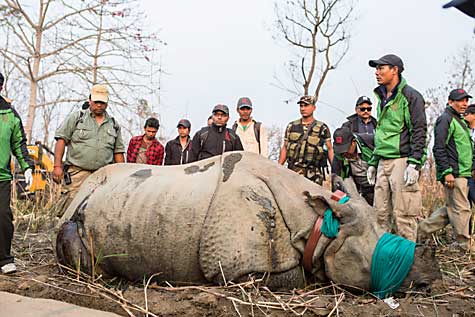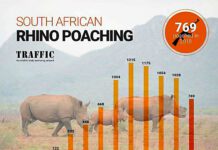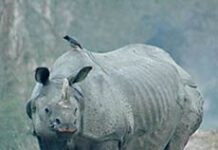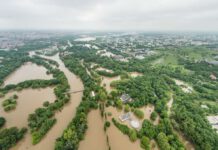
Kathmandu, Nepal – A Greater one-horned rhino found a new home in Bardia National Park through a successful translocation expedition from Chitwan National Park in Nepal’s Terai Arc Landscape (TAL) today.
In the coming days, four additional rhinos will make this trek, all part of a larger effort to move 30 rhinos to Bardia National Park (25 rhinos) and Shuklaphanta Wildlife Reserve (5 rhinos) through 2018.
“The expedition is an important step towards creating a second viable population in the western complex of TAL comprising Bardia National Park and Shuklaphanta Wildlife Reserve,” stated Honorable Minister of Forests and Soil Conservation, Agni Prasad Sapkota. “Our bigger goal is to bring back rhino numbers to its historical size of 800 in Nepal.”
The rhino, an adult male, was first tracked and sedated in Chitwan National Park on 1 March. It was then fitted with a satellite collar and loaded on to a specially designed truck to transport it safely to the fertile Babai Valley in Bardia National Park where it was released on 2 March.
The translocation, which involved the use of 33 elephants and a team of about 250 people, was led by the government’s Ministry of Forests and Soil Conservation with the support of WWF Nepal, National Trust for Nature Conservation, Nepal Army and local communities. The translocation was funded by WWF’s AREAS Program, WWF US, USAID and US Fish and Wildlife Service.
Rhino translocation in Nepal dates back to 1986 when the first batch of 13 rhinos was translocated from Chitwan National Park to Bardia National Park. By 2003, 87 rhinos were translocated through seven separate events in Bardia National Park and Shuklaphanta Wildlife Reserve. As a positive trend, 27 calves were born in Bardia between 1986 and 2000. However, in Babai Valley of Bardia National Park, where a majority of the rhinos had been translocated, almost all of the rhino population was wiped out on account of poaching during the peak insurgency period between 2002 and 2006.
“Nepal has come a long way since 2002 when we lost 37 rhinos to poaching in a single year,” stated Anil Manandhar, Country Representative of WWF Nepal. “With rhino populations at an all-time high in Nepal in 2015, the government, its conservation partners and local communities understand the need to double up efforts, the rhino translocations being one of them, to build a better future for this iconic species of Nepal.”
Nepal achieved 365 days of zero poaching of rhinos on three separate occasions since 2011, and Nepal’s rhino population is in a growing trend with 645 rhinos recorded in the country based on the rhino count of 2015. In Bardia alone, rhino populations grew from 24 to 29 as compared to the previous count in 2011. This is primarily accounted for by the heightened security measures within protected areas; in Bardia alone, there are 33 guard posts that provide protection to iconic wildlife such as rhinos and tigers. Given top level commitment in rhino conservation, a well-coordinated protection response between the national parks, Nepal Army, Nepal Police and local communities, and the support of conservation partners such as WWF and the National Trust for Nature Conservation, Nepal’s rhino population could well be on a growing trend in the backdrop of the successful rhino translocations.
World Wide Fund For Nature Nepal
www.wwfnepal.org









